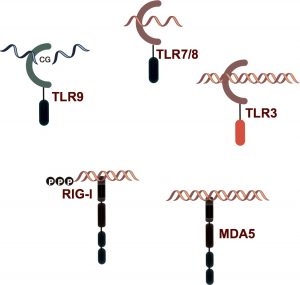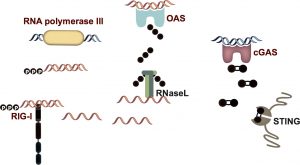Several research groups within the ImmunoSensation Cluster of Excellence have been involved in the identification and characterization of pattern-recognition receptors and their ligands. Recently, Prof. Veit Hornung from the Institute of Molecular Medicine created a graphical overview of the pathways and their signaling molecules involved in nucleic acid recognition published in the Immunity SnapShot series Nucleic Acid Immune Sensors Part 1 and Part 2. Here, we also shortly summarize the common mechanisms involved in the recognition of microbes via their genomic material or microbial nucleic acids products.
Basically, the underlying principle of the innate immune system to recognize pathogens is the recognition of foreign patterns, known as Pathogen Associated Microbial Patterns (PAMPs). This mechanism was proposed quite presciently by Charles Janeway in 1989 (the Janeway after whom THE Immunology Textbook is named). And indeed, the first receptors recognizing such patterns were identified almost 20 years ago in the fruit fly, drosophila.
This finding marked the beginning of a renewed interest in innate immunity research and set the stage for the identification of a numerous other receptors relying on the recognition of distinct patterns. (Previously, immunologists had focused on adaptive immunity and mainly studied B- and T-cells.)
As our immune system co-evolved in the presence of a broad variety of pathogens, there are several receptors and pathways recognizing microbial structures and inducing an immune response to fight the invaders.

Direct nucleic acid sensors (adapted from http://www.sciencedirect.com/science/article/pii/S1074761314003616)
The immediate initiation of an antimicrobial, in particular antiviral immune response, often relies on recognition of nucleic acids. These nucleic acids are recognized by means of foreign (non-self) structures or due to their localization. In the current paradigm, there are two strategies to recognize nucleic acid structures and to induce pro-inflammatory genes and type I interferons. First, there is a set of receptors directly recognizing RNA or DNA molecules such as the RIG-I-like receptors (RLRs) and Toll-like receptors (TLRs) Secondly, other systems bind double stranded (ds)RNA or DNA species and subsequently produce ligands, which in turn activate pattern recognition receptors (PRRs) to induce an antiviral response.
First hand nucleic acid receptors
The TLRs were the first family of PRRs discovered. Those that are known to detect nucleic acid are localized in the endosome. Here, TLR3 binds dsRNA; TLR7/8 binds ssRNA, and TLR9 binds CG-rich ssDNA. All three receptors induce an antimicrobial immune response on activation. In case of the cytosolic RLRs, RIG-I recognizes foreign RNA structures (classically short dsRNA with free triphosphate ends) whereas MDA5 activates an antiviral response when encountering long dsRNA.
Ligand-producing nucleic acid recognition systems

indirect sensors of nucleic acids (adapted from http://www.sciencedirect.com/science/article/pii/S1074761314003628)
In addition to these direct pathways, RNA polymerase III, which binds to dsDNA, produces short triphosphate RNAs which in turn activate RIG-I to induce an interferon response. Oligoadenylate synthetases (OAS) bind dsRNA and subsequently synthesize messenger molecules activating RNaseL to generate ssRNA species with the ability to stimulate RIG-I.
The most recently identified recognition receptor is cGAS. This nucleotidyltransferase synthesizes the second messenger molecule cyclic G/AMP (cGAMP) when binding to dsDNA in the cytosol, where DNA normally is not present. The characterization of the second messenger cGAMP was also the work of ImmunoSensation Cluster members. Furthermore, Cluster researchers could show, cGAS mediates a transferable antiviral signal since cGAMP is also transferred to neighboring cells via gap junctions and thus protects surrounding cells from viral threat.
Interaction with other cellular pathways
There is evidence that also other cellular pathways are involved in the induction of an innate immune response. First, for example, viral proteins interfere with several cellular mechanisms including the activation of PRR pathways, which induce an antiviral response, as well as the engagement of DNA damage pathways. Secondly, several viruses are known to induce DNA damage. Thirdly, for other model organisms, like the worm C. elegans or drosophila, DNA damage is already known to induce an antimicrobial response.
In humans, some publications indeed demonstrate the direct involvement of the proteins of the DNA damage response pathway during the activation of innate immune responses.
Thus, to date, multiple pathways have been identified by which microbial nucleic acids are recognized. Still, it remains to be studied how these pattern recognition pathways are connected to other cellular signaling pathways. These connections may help us to gain more insight into the processes involved not only in viral infections but also in aging or cancer.

Author: Klara Höning

Pingback: The Cluster goes Christmas – ImmunosensationBlog